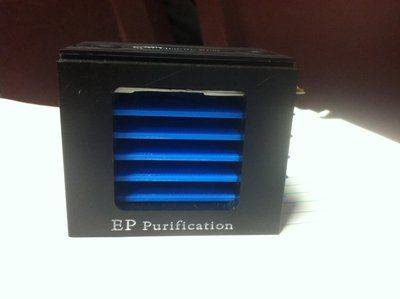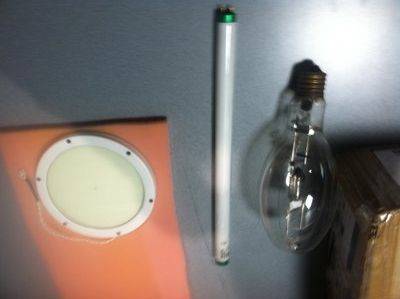 He starts with a lamp. When he turns it on, a bright square light permeates the room. It’s an invention made through his company Eden Park Illumination. The bright square light is powered by plasma. And that’s the topic of his lecture.
He starts with a lamp. When he turns it on, a bright square light permeates the room. It’s an invention made through his company Eden Park Illumination. The bright square light is powered by plasma. And that’s the topic of his lecture.
The auditorium is packed. They’ve come to see a man skilled at his craft. Gary Eden is his name, and he’s a professor at the University of Illinois, Champaign-Urbana, in the field of engineering. He studies optics, lasers, and plasma, and the last of which is the focus of his lecture—what microplasma is and how it can help improve lives.
As P. Scott Carney, one of the organizers of the lecture, says: “Gary is a master of taking very sophisticated ideas and making them accessible to anyone, and making it exciting for them.”
And he does. Written on the blackboard behind him are block letters: “GOING WHERE NO PLASMA HAS GONE BEFORE…”
People are intrigued. They are standing behind the back row of chairs, watching.
“We are the oddities in the universe,” Eden states. “99.999 percent of the universe is made up of plasma. I’m not talking about the plasma that you donate. I’m talking about the plasma that is all around us.”
It’s a mix in the crowd. Engineering professors, engineering students, parents with kids, old men, young men, old women, young women—they’ve all turned out to see the first lecture in the series, a lecture about plasma, a lecture really about plasma and light.
He explains about microplasma, which is plasma trapped in cavities the size of the width of a human hair. In these cavities, they can be formed into arrays, like arrays of lights, sometimes so small you would have to look through an electron microscope to see them.
Then, his question: “What can we do with this?” he asks.
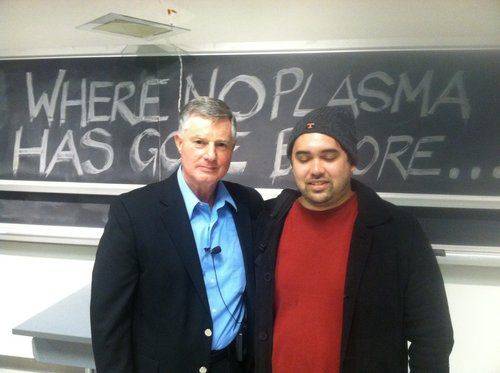
And he knows the answer too, because he has studied this for years. In 1995 or 1996 a graduate student came to him with the idea of putting plasma in a hole within a block of silicon. Sure, Eden said. Why not? Well, that one experience proved the boon. It started his fascination with plasma and the journey to explore the limits of plasma technology.
After the overview of microplasma, he starts with lamps. He pulls out a standard fluorescent tube and then a large streetlamp bulb. “There is nothing,” he states, “that says you must have this shape… it’s ugly. The ideal shape for a light is something that is flat.”
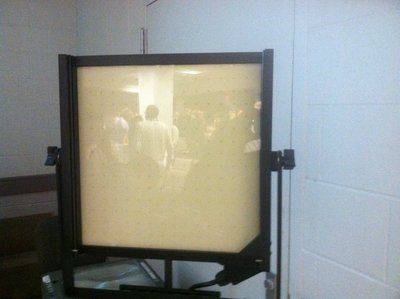
That’s when he turns on the square lamps, thin sheets of light that contain microplasma arrays that use energy far more efficiently than standard bulbs. He runs pictures on the overhead projector. There are those flat, square lamps arranged in a chandelier, in shelving, in counters. In the solar decathlon, the University of Illinois team used these flat, square lamps to help build an energy efficient home.
“You know when you were a kid and you went to school,” Eden says. “What was your favorite part of class? Mine was show and tell. I want to do demonstrations that show the interesting nature of plasma.”
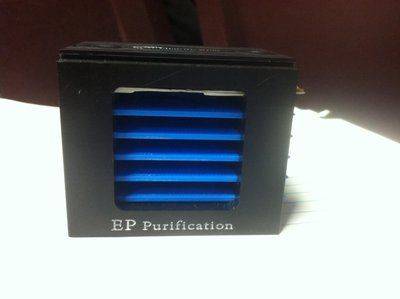 The flat, square lights are just the start. He goes on through his lecture with ease, calmness, and poise. He talks about specific microplasma that emits ultraviolet rays, which can disinfect water. Then he pulls out the big guns.
The flat, square lights are just the start. He goes on through his lecture with ease, calmness, and poise. He talks about specific microplasma that emits ultraviolet rays, which can disinfect water. Then he pulls out the big guns.
He has a system rigged up with a camera focused on it. It’s a system that has cylinder of water with blue dye, so that it looks like the color of the sky. It’s the dye used in paints, Eden says. Then he turns on the machine.
The UV microplasma sheet of light kicks on and slowly the blue dye is killed. The water turns clear and all is well. That is the power of microplasma, he says. Now, imagine if this sheet of light is twenty times its size and water is running past it. It will disinfect the water, kill off the impurities.
“That’s what we’re about,” Eden says. “How can I make life better for other people?”
Cleaner air, cleaner water. And then there’s the real kicker—applications in the field of medical therapeutics. He shows a series of pictures of people with jaundice, acne, and others illnesses. He tells how microplasma can help people with these conditions.
Then he talks about the new school medical tools, which are like a handheld square with microplasma lights jutting out of them. It’s a powerful looking tool and powerful period. In clinical trials in Korea, they are testing it for abilities to accelerate wound healing, especially burns and cuts.
“Plasma is being used for life, to improve life, for a healthier and better future,” he says.
About engineering in general, he states, “It’s like taking something and saying, ‘How can we do something with this that’s useful?’ It’s an intoxicating idea. It’s like a virus that gets in your bloodstream. It has a real impact on lives.
“My Dad worked for AT&T. My Dad has always had the love for making things. He was really an expert at making things. Out of really simple materials, he would make something for the house. I would work with him several nights a week.
“Engineers more than any other discipline are devoted to improving our lives.”
At the end of the lecture, he answers question after question. Most are technical questions about watts and power outages and so forth. And then he is through. The people, young, old, male, female, of all races, linger at the food table or exit through the back of the auditorium.
What is the one thing he wanted to communicate to them through this lecture?
“For the audience, the potential that is out there to do good,” he says.
For more information about the next lecture, check this out.








